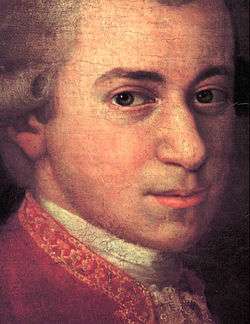String Quartet No. 18 (Mozart)
Wolfgang Amadeus Mozart's String Quartet No. 18 in A major, K. 464, the fifth of the Quartets dedicated to Haydn, was completed in 1785.[1] Mozart's autograph catalogue states as the date of composition "1785. / the 10th January".[2] It is in four movements:
- Allegro
- Menuetto and Trio
- Andante (theme with variations)
- Allegro non troppo
The whole piece is characterized by the use of several different contrapuntal devices.[3] In England "this quartet is known as the Drum because the cello part in variation six [of the Andante] maintains a staccato drum-like motion."[4]
This quartet was the model for Beethoven's String Quartet in A major, Opus 18 No. 5.[5]
In his biography of Mozart entitled Mozart: A Life, musicologist Maynard Solomon quotes Beethoven as telling his pupil Carl Czerny that this work with its complex contrapuntal techniques, was Mozart's way of saying to the world, "Look what I could produce, if only you were ready for it."
Even though it is one of Mozart's longest quartets, there is a great economy to the writing. The finale is as monothematic as anything Haydn ever wrote, with all the development deriving from the opening two phrases, and the other movements use of a very small amount of melodic material for their development sections as well. The minuet for example, builds primarily on just two small motifs.
References
- ↑ John Irving, Mozart: The 'Haydn' Quartets. Cambridge: Cambridge University Press (1998): 13. "K. 464 and K. 465 were entered ... into Mozart's own handwritten thematic catalogue ... on 10 and 14 January [1785], respectively."
- ↑ Mozart, Wolfgang Amadeus; Finscher, Ludwig (preface); Anderson, Kinloch (transl.) (2007). The Ten Celebrated String Quartets. Kassel: Bärenreiter Verlag. pp. XI. Cite uses deprecated parameter
|coauthors=(help)ISMN M-006-20118-1 - ↑ Reginald Barrett-Ayres, Joseph Haydn and the String Quartet. London: Barrie & Jenkins (1974): 197. "Every form of contrapuntal device is used here."
- ↑ Barrett-Ayres (1974): 198
- ↑ Nicholas Marston, "Chamber music for strings alone" The Beethoven Compendium: A Guide to Beethoven's Life and Music ed. Barry Cooper. Ann Arbor: Borders Press (1991): 233
External links
- String Quartet No. 18: Score and critical report (German) in the Neue Mozart-Ausgabe
- String Quartet No. 18: Scores at the International Music Score Library Project
- Performance of String Quartet No. 18 by the Borromeo String Quartet from the Isabella Stewart Gardner Museum in MP3 format
